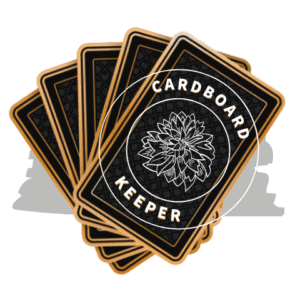Planeswalkers are not only some of the most powerful cards in Magic The Gathering, they are arguably the most interesting. I love the fact that Planeswalkers come in all shapes, sizes and have an almost endless array of abilities, but this wide variety of choices made it somewhat difficult to understand how to use a Planeswalker when I first started playing MTG.
As a general rule, Planeswalkers can be used to give a player an additional effect once per turn by paying the activation cost of a Planeswalker’s Loyalty ability. The effect granted to the player will be different depending on which Planeswalker and what Loyalty ability they activate.
Sounds simple right? And for the most part, it is.
However, if you are new to Magic The Gathering there are few fundamental things you need to know about Planeswalkers in order to be able to use them correctly.
Don’t worry though, I remember what it was like when I first started to learn how to play and being afraid to ask questions that everyone else already seemed to know the answer to. Below I’ll walk you through everything I wish I had known when I first started casting Planeswalkers in Magic The Gathering.
How Does A Planeswalker Card Work?
You cast Planeswalker spells the same way you would cast any normal spell in Magic The Gathering, by paying its mana cost.
Planeswalkers are non-land permanents. Once you have paid the mana required to cast a Planeswalker and they have successfully resolved, they will enter the battlefield. Whenever a Planeswalker enters the battlefield, they will come into play with a preassigned number of loyalty counters.

Planeswalkers are all about Loyalty Counters.
It can be best to think of loyalty counters as fuel for your Planeswalker card or, better yet, like the mana you need to cast spells in a game of Magic.
If you don’t have any Lands or mana in a game of Magic, you aren’t going to be able to do much of anything – the same is true for Planeswalkers and Loyalty counters.
How Do Planeswalkers Get Loyalty Counters?
Planeswalkers get loyalty counters when they enter the battlefield. On the bottom right-hand corner of a Planeswalker card, there is a number that represents the number of loyalty counters a Planeswalker will enter the battlefield with. Also often referred to as a Planeswalker’s “Starting Loyalty“
In the case of “Jace, Ingenious Mind-Mage”, he enters with 5 Loyalty counters (See Point 6 in the image above).
What makes Planeswalkers so interesting is that Loyalty counters don’t just act as a fuel source for Planeswalkers to activate their abilities, but they also act as life points for your Planeswalkers.
If the amount of loyalty counters a Planeswalker has ever reaches 0, they die and go to the graveyard.
FUN FACT: In the Lore of MTG, planeswalkers don’t actually die when they reach 0 counters, instead they are no longer Loyal to you and they choose to leave the battlefield. That’s why they are called “Loyalty counters” – they determine how loyal a Planeswalker is to you.
So now that we know how to successfully cast and place the correct amount of loyalty counters on a Planeswalker when it enters the battlefield (“Starting Loyalty”), how do we go about using those awesome Planeswalker abilities?
How To Use A Planeswalker Card
Once per turn, you can spend a Planeswalkers loyalty counters to activate 1 of their “Loyalty abilities.“
Loyalty abilities and the cost associated with them can be found underneath the text that states their card type, “Legendary Planeswalker“.
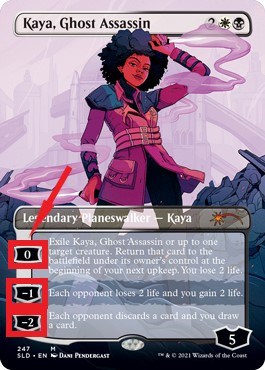
A Planeswalker will typically have 2 – 4 activatable loyalty abilities for you to choose from. Each ability will have an assigned cost to it that you must pay in order to use that ability.
To pay the activation cost of a Planeswalker ability, you simply adjust the number of loyalty counters your Planeswalker currently has according to the number assigned to the ability you want to activate.
For example, if we wanted to activate the last ability on the card “Kaya, Ghost Assassin”, we would need to pay “-2” loyalty counters from Kaya’s current loyalty counter total.
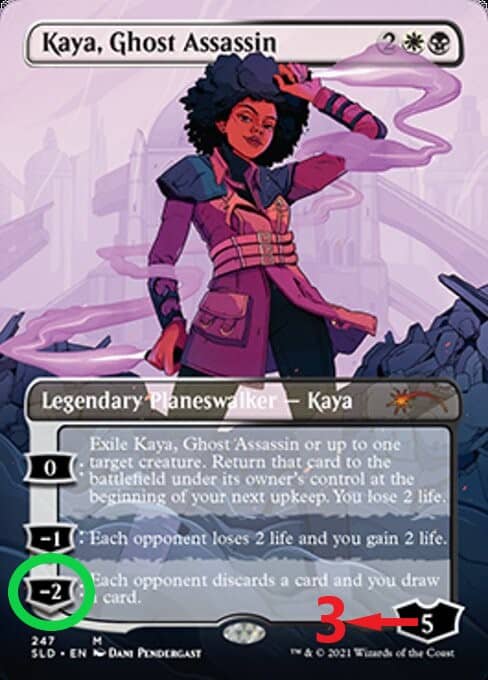
Remember, even though in this example Kaya would still have 3 loyalty counters left, you can’t activate another ability in the same turn.
That means you will have to wait until the next turn to activate her again – seems fair right?
A key thing to remember when it comes to Planeswalker’s abilities is that you can only activate them if you have enough loyalty counters on that Planeswalker to do so. If Kaya only had 1 loyalty counter left, we would not be able to activate her “-2” ability.
We would be forced to choose either of her other 2 abilities.
You may have already noticed, but one of Kaya’s abilities has a cost of “0“.
No need to be confused. Even though we often talk about “paying” the activation cost of a Planeswalker’s ability, sometimes that ability won’t actually require you to trade any of your Planeswalker’s counters to do so. You simply pay 0 counters to use it.
Even though you didn’t lose any loyalty counters from activating this ability and Kaya would stay at 5 counters, you can still only activate 1 ability once per turn – No double-dipping on activating abilities on the same card.
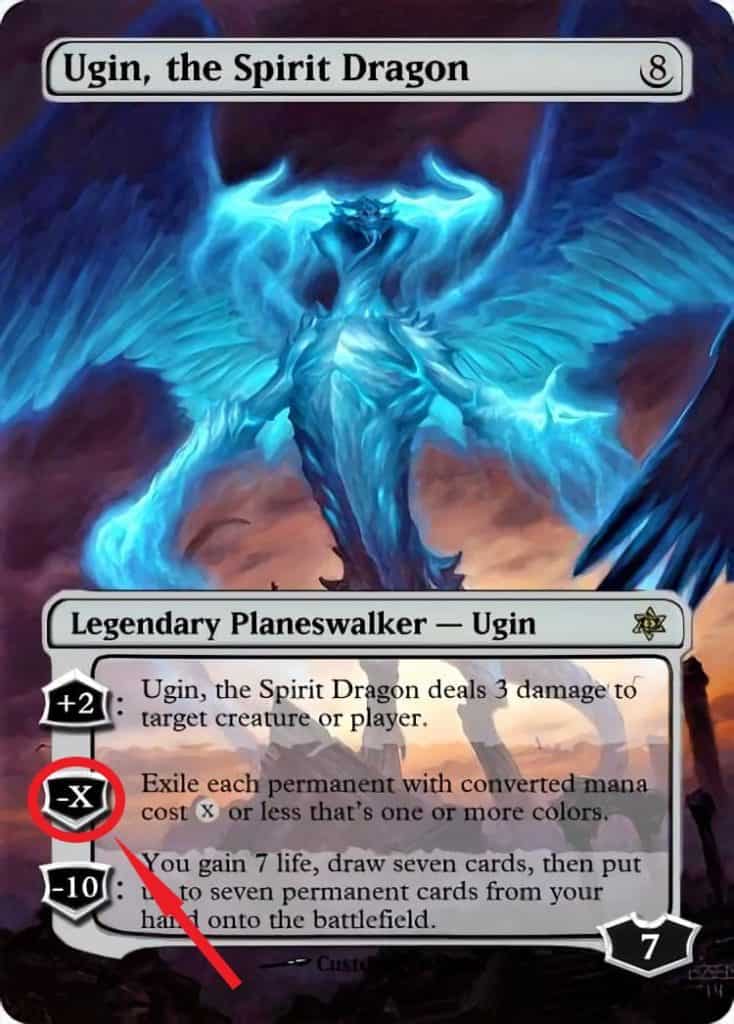
Occasionally, you may run into a Planeswalker that has an ability that requires you to pay “-X” to use one of its Loyalty abilities.
Using “Ugin, The Spirit Dragon” as our example, you can see that his second ability requires you to pay “-X”.
When you see “X” in the payment cost of a card in Magic The Gathering, it normally refers to a number that varies depending on what you choose to pay. In this example, you can choose to pay any number of loyal counters you would like from Ugin to activate his second ability (You may also choose to pay “0” when you activate the ability – I wouldn’t recommend it though).
Depending on how many of Ugin’s loyalty counters you choose to spend to activate his second ability, will change the effect of what will happen when it activates.
−X: Exile each permanent with mana value X or less that’s one or more colors.
Ugin, the Spirit Dragon[2]
Just remember, you can choose whatever number you would like to pay with an “X” cost as long as you can pay it. If Ugin only has 7 loyalty counters, you may not choose to pay 8 for the X ability – The amount of counters your Planeswalker has is the limit.
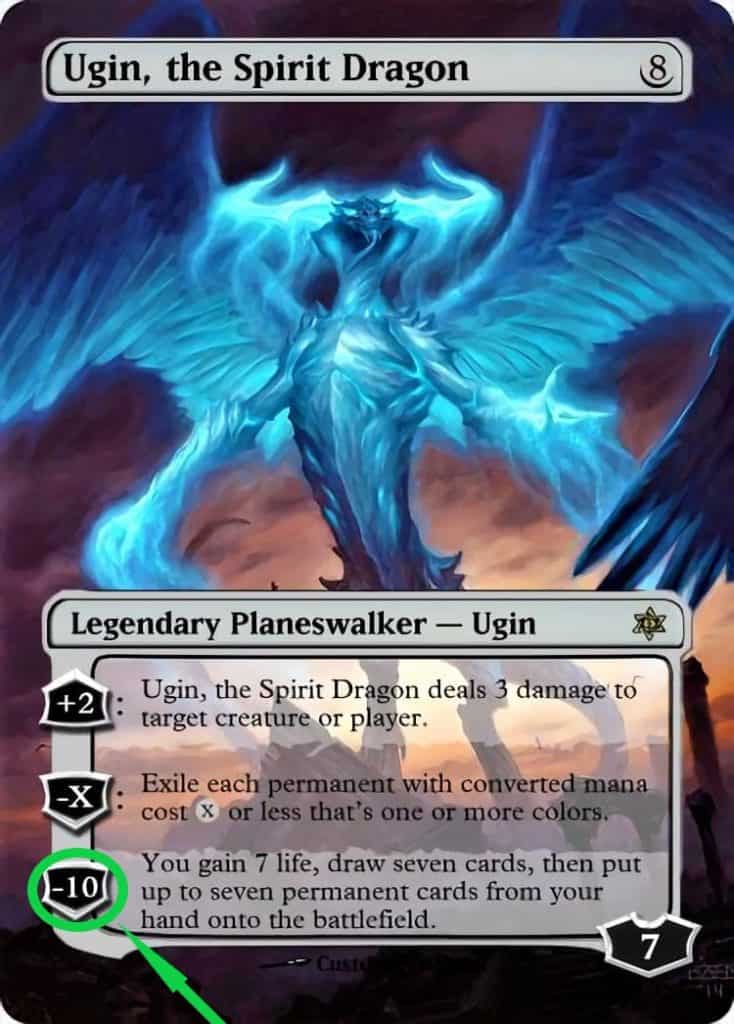
One last thing you should know when it comes to spending loyalty counters to activate abilities – something that will help to know what other Magic players are referring to when they mention an “Ultimate“.
Although not always the case, often the final ability on a Planeswalker will have a large cost to it and is often referred to as an “Ultimate” by Magic players.
The name came from the fact that if a player is able to activate the ultimate ability on a Planeswalker card, it normally means that player is going to win the game.
Of course, that isn’t a hard rule. I have played a few games of Magic where I have fought through my opponent’s Planeswalker “ultimating” and I have gone on to win the game. But it is a very steep, uphill battle.
It’s important to always keep track of how close your opponent’s Planeswalkers are to being able to use their ultimate ability (if the card has one), and stop it from doing so whenever possible.
I have won a few games where this has happened, but not many…
How Do You Add Loyalty Counters To Planeswalkers?
As a general rule, you can add loyalty counters to Planeswalkers by activating a Planeswalker’s loyalty abilities that increase the number of counters on a Planeswalker card. Some Planeswalkers will have abilities with a “+” symbol in the activation cost that will require a player to add counters.
Just like with Kaya’s ability that requires you to pay “0”, many Planeswalkers have abilities where the cost of activating the ability requires you to add Loyalty counters to a Planeswalker.
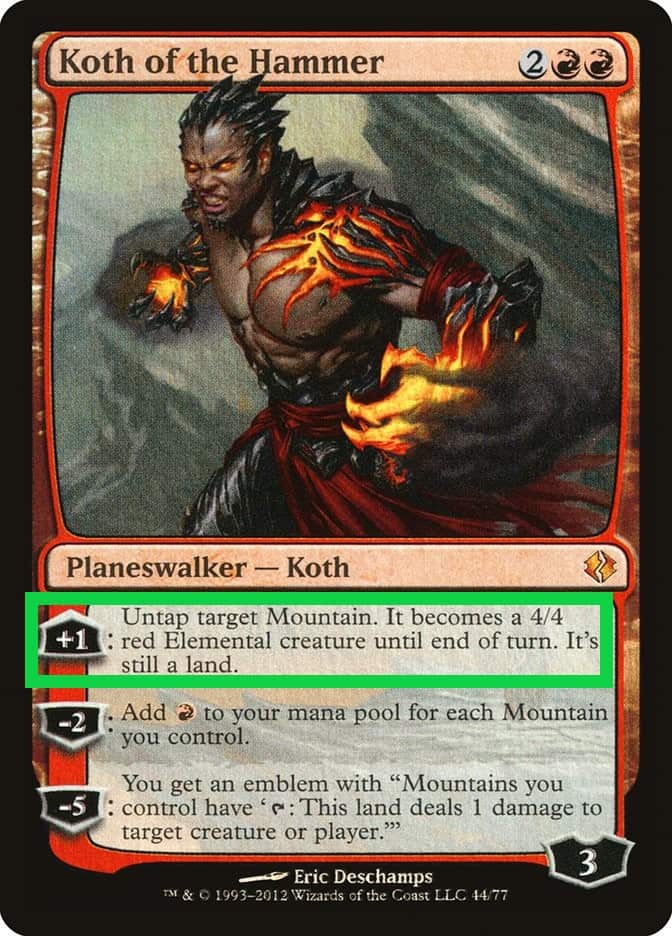
In the example above, we can see “Koth of the Hammer” has an ability that requires you to add a loyalty counter to Koth to activate it.
By activating his “+1” ability, Koth’s starting loyalty would go from “3” to “4“. This is by far the most common way to add additional loyalty counters to a Planeswalker.
By adding additional counters to a Planeswalker, you get closer to activating that game-ending ultimate ability they normally possess.
Tip: When trying to keep track of your Planeswalker’s loyalty counters in a game of Magic, it’s best to use a 6-sided dice. Place the dice on top of the Planeswalker’s starting loyalty counter number in the bottom right-hand corner of the card. Just change the number facing upwards on the dice to match the Planeswalker’s current amount of loyalty counters.
However, using Planeswalker abilities that require you to add counters isn’t the only way to add loyalty counters to your Planeswalkers.
There are many effects on cards throughout Magic’s history that allow you to add counters to a permanent you control. A popular card ability that is well known by most Magic players that allows you to do this is “Proliferate”.
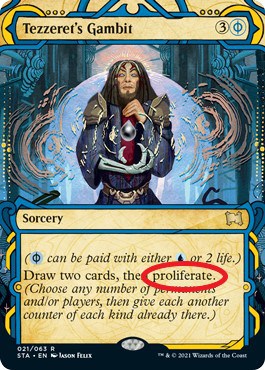
To proliferate, you can choose any permanent that has a counter, including ones controlled by opponents. You can’t choose cards in any zone other than the battlefield, even if they have counters on them.
Gatherer.wizards.com[3]
Cards that have effects like “Proliferate” give you alternative ways to add counters to Planeswalkers you control besides just using a Planeswalker’s abilities.
Although these alternative ways are not extremely common in the game of Magic, it’s good to be aware that they do exist and you may run into them from time to time.
When Can You Use Planeswalker Abilities?
As a general rule, a Planeswalker’s ability can be activated once per turn in a player’s “Pre-combat Main Phase” or “Post-combat main phase”. Planeswalker abilities that require activation can not be used in any other phase of the game.
306.1 A player who has priority may cast a planeswalker card from their hand during a main phase of their turn when the stack is empty. Casting a planeswalker as a spell uses the stack.
Official Magic The Gathering Rules[4]
The turn structure in Magic The Gathering can be a little confusing to fully wrap your head around when first starting to play the game. Players will often refer to parts of a turn by different names rather than the official verbiage used by Wizards of the Coast.
And so, just to make sure I haven’t confused you, here is another way of explaining when you can activate a Planeswalker’s ability in a turn.
The activation of a Planeswalker’s ability can be done in either your “Main Phase 1” or “Main Phase 2“.
You can not activate a Planeswalker’s loyalty ability in the “Beginning Phase” (Upkeep), the “Combat Phase” or “Ending Phase” (End Step).
Can You Use A Planeswalker Ability As An Instant?
As a general rule, a Planeswalker ability can not be used as an instant and can only be activated at “Sorcery speed”. Planeswalker abilities can only be activated when a player has priority and the stack is empty. A Planeswalker ability can not be used in response to another spell.
Currently nearly every Planeswalker in the game is bound by these activation rules, unless they state otherwise.
Don’t worry though, there aren’t many exceptions to the rule that you will have to memorize, in fact, there is just 1 Planeswalker that does not abide by these rules. And why would he? He is the master of time after all.
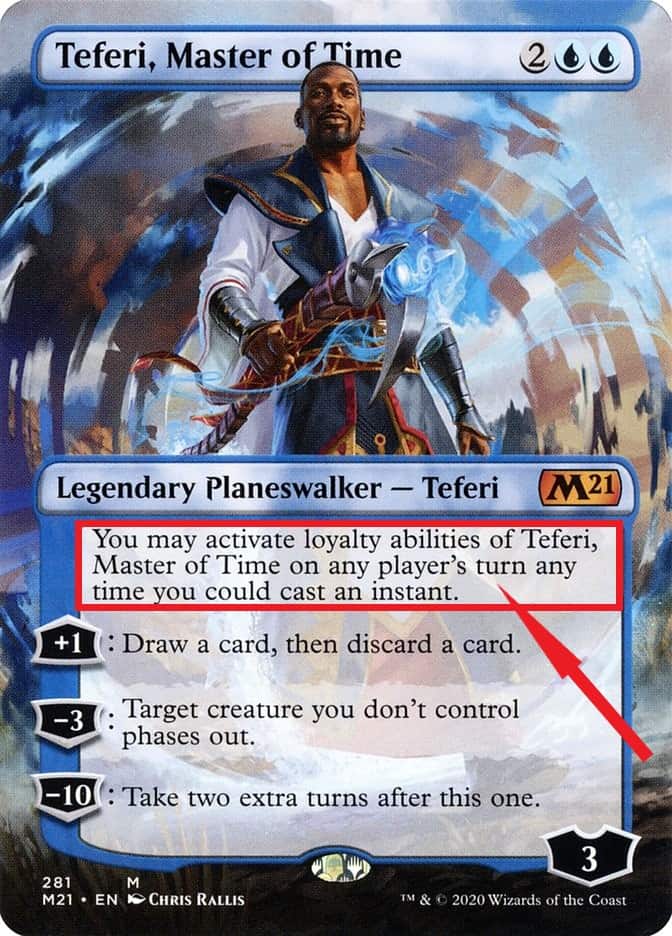
You may activate loyalty abilities of Teferi, Master of Time on any player’s turn any time you could cast an instant.
Wizards.com. Gatherer – Magic: The Gathering.[5]
“Teferi, Master of Time” has special rules text that gives him permission to activate his abilities at instant speed. He can still only activate 1 loyalty ability per turn, but he can choose whenever he would like to activate that ability.
He can even activate his abilities in response to spells – pretty powerful right?
However, just remember that most other Planeswalkers that are not the master of time, will be stuck only activating their abilities only at sorcery speed.
Can You Use Planeswalker Abilities On Opponent’s Turn
As a general rule, Planeswalkers can not activate their abilities on an opponent’s turn. Some Planeswalkers have unique rules text that grants them passive abilities that are active continuously as long as they are in play, but they do not require activation.
Just like in our previous example with Teferi, Master of time, you will find some Planeswalkers have special rules text on them that gives them static abilities that are active during both player’s turns.
These special static abilities are sometimes referred to as “Passives“.
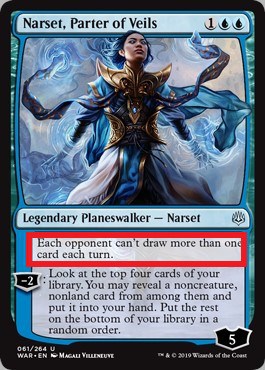
Each opponent can’t draw more than one card each turn.
Wizards.com. Gatherer – Magic: The Gathering.[6]
These passive abilities do not change the fact that Planeswalkers can’t activate abilities on your opponent’s turn – unless your Teferi, Master of Time whose passive ability explicitly states he can – since passive abilities do not require an activation.
A passive ability will immediately be switched on as soon as a Planeswalker enters the battlefield, if they have one, and will continue to be active regardless of whose turn it is.
In the case of “Narset, Parter of Veils”, it is always a good idea to do an extra card drawing before she enters the battlefield. Once your opponent has her in play, you won’t be able to draw more than one card per turn even if a spell says you can!
So be careful and always check if a Planeswalker has a passive that you might need to worry about as passive work on both players turns.
Does Deathtouch Work On Planeswalker?
As a whole, Deathtouch does not work on Planeswalkers. The Deathtouch ability only affects creature cards. If a creature will death touch assigns damage to a Planeswalker, that Planeswalker will only leave the battlefield if they no longer have any loyalty counters after taking damage.
This question is something that gets asked a lot by new players and so I thought it would be best to add a section about it.
702.2b A creature with toughness greater than 0 that’s been dealt damage by a source with deathtouch since the last time state-based actions were checked is destroyed as a state-based action.
Rules Resources.[7]
The official ruling for this is a little bit wordy. However, the main thing you should focus on in the ruling is that it explicitly states “creature“.
Planeswalkers are not creature cards and therefore Deathtouch has not effect on them.
So rest assured, if your Planeswalker gets attacked by a creature with Deathtouch, you won’t have to send your Planeswalker to the graveyard, unless that creature has done enough damage to remove all of that Planeswalker’s loyalty counters.
Can You Have 2 Planeswalkers On The Field?
A player may have more than 2 Planeswalkers on the field at the same time. As long as each Planeswalker in play has a different card name then a player is not limited to 1 Planeswalker at a time. Planeswalkers are still subject to the “Legendary rule”.
What fun would Planeswalkers be if you could only have one at a time?
It actually used to be the case that players could only have 1 type of Planeswalker in play at a time, which was referred to as the “Planeswalker Uniqueness Rule“.
This rule has been altered on a few occasions and was then eventually replaced by the “Legend Rule” which dictates just how many Planeswalkers you can have in play at once.
If you are interested in learning about just how many Planeswalkers you are allowed to have in play at one single time, check out my full blog post on the topic where I tell you everything you need to know – Maximum Number of Planeswalkers in Play [Formats, Rules]
With that, I think we have covered all of the fundamental things you need to know about using a Planeswalker.
There are a few more important aspects of Planeswalker you will need to understand before you can claim your degree in Planeswalker Management, but the information in this post should be more than enough to get you up and running with casting Planeswalkers in Magic.
If you are looking to broaden your knowledge on Planeswalkers, check out some of my other posts on the topic, where I break down everything you need to know about these awesome mages of the multiverse.
